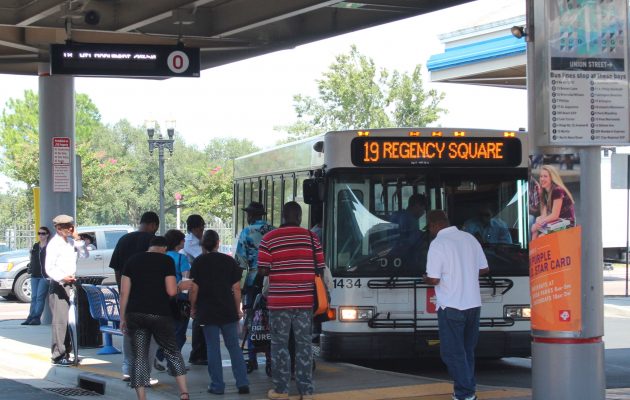JTA has answers for riders struggling with Route Optimization

When Jacksonville Transportation Authority (JTA) inaugurated its Route Optimization Initiative on Dec.1, 2014, it expected to hear concerns from regular riders fearful of change.
The initiative overhauled Jacksonville’s outdated public transportation system by reorganizing routes, doubling the number of buses to 22 that pick up riders at half-hour intervals. More evening and weekend service was added, as well as 16 routes after midnight – important for those working odd hours or enjoying Jacksonville’s night life.
While JTA projected a three-percent decrease in ridership of the overhauled public transportation system, according to Leigh Ann Rassler, JTA public relations manager, it was a pleasant surprise to discover nine months later that August ridership this year was up 6.2 percent over the prior year, and Saturday and Sunday increased by 10.7 percent and 13.5 percent respectively, Rassler said. JTA keeps track of transfers, which would add minimal overlap to overall ridership numbers, she noted.
Despite improved numbers, City Hall volunteer worker Bernard Mazie, 72, of Lakewood, is less than impressed and has bold, colorful terms for the initiative.
“Route Optimization is a curse upon humanity, a kleptocratic sarcoma, and a disease of thievery,” he opined, describing the increased travel times he faces due to additional transfers on his new route to his volunteer job at City Hall, and the additional transfer expenses he said other riders are forced to bear.
Prior to Route Optimization, to get to City Hall, Mazie had a direct 17-minute commute.
“I would take the B7 to Forsythe and Laura, and it was only a two-block walk to City Hall or the library from there, and no crossing San Jose or University Boulevard,” he said.
After Route Optimization, Mazie’s trip involves a transfer from a bus to the Skyway and takes 42 minutes, more than twice as long. He also said that a trip to Regency Mall now involves two transfers and 55 minutes versus no transfers in 44 minutes before the route changes went into effect.
With the cost of additional transfers, Mazie said, those earning minimum wage must now put almost an hour of their wages into bus fare.
An increased number of transfers after Route Optimization is also cited by Matt Uhrig, founder of Bike Jacksonville, as a reason for his move from the Racetrack Road area into Riverside.
“I moved to Riverside because optimization made it so difficult; I had to make the move,” he said. “Now people have to pay double fees because of additional transfers.”
However, Rassler stated that the JTA always looks at ways it can improve routes, based on customer feedback. “If people don’t give us their feedback, we don’t know what their concerns are,” she cautioned.
“We want to make it as easy as possible for riders to go where they want to go,” said Rassler about ridership difficulties and confusion. “You can call the customer service main number at (904) 630-3100 for help. If needed, someone from Community Engagement can meet you in person to help. If someone is doing more (transfers) we’re happy to work with them to find the best route.”
Transfer connections highlight Jacksonville’s pedestrian dangers
Safety issues are another factor for the elderly, who risk injury by getting on and off multiple buses, Mazie said, noting how hard it is for the elderly riders to cross intersections to complete a transfer.
“The thought of crossing those streets is frightening. They (motorists) bear down on you and they don’t move – sometimes they even go for you,” Mazie said.
“We have the highest vehicle-to-pedestrian accident rate in the country,” said Terry Barton, CEO of Aging True, a Community Senior Services organization with headquarters in Lakeside.
“Vehicles can turn right on red, even though the pedestrian has a walk signal,” Barton added.
Jacksonville was not planned to be a pedestrian city, and now has to retrofit itself to accommodate pedestrians and bikes, she said.
In a National Complete Streets Coalition study released in 2014, Jacksonville’s pedestrian safety was ranked third worst in the United States.
Rassler said JTA is working on a mobility corridor to improve stops and shelters, and is currently getting community input to help with those improvements.
As for ridership costs, a monthly pass from JTA is available for $50 and covers all rides, she said.
JTA’s Transit Commuter Tax Benefits Program allows participating employers to deduct the $50 monthly pass fare, pre-tax, from an employee’s paycheck. The employee receives a special debit card that can only be used to purchase fare at ticket vending machines, Rosa Parks Station, or through JTA’s website.
Route Optimization Initiative includes an interactive, GPS guided map and scheduling tool, where riders can plan their desired route and find out when their bus is due. The NextBus app and website (www.nextbus.com/predictor/stopSelector.jsp?a=jtafla) provide real-time arrival information, allowing riders to plan their trips accordingly.
By Vince Iampietro
Resident Community News






